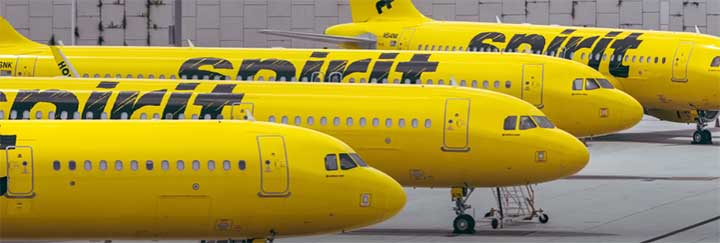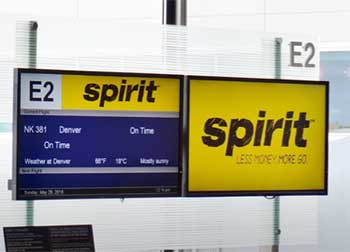Spirit Airlines has become known in recent years for offering some of the cheapest airfares around. While this can be great news for budget-conscious travelers, it does make some people wonder – how can Spirit offer such low fares, and what’s the catch?
There are a few key reasons why Spirit is able to keep their costs, and therefore ticket prices, so low compared to other major airlines.
6 Reasons Why Spirit Airlines So Cheap
- Lower Operating Costs
- Secondary Airports
- Demand-Based Pricing
- Direct Sales Approach
- Optimized Flight Operations
- Growth and Economies of Scale
Let’s talk about them in detail!
Lower Operating Costs

One of the biggest factors that allows Spirit to offer cheap ticket prices is that their operating costs are much lower than other airlines. Spirit has structured their entire business model around reducing expenses wherever possible.
- Highly Efficient Fleet
Spirit only operates a single type of airplane – the Airbus A320 family. Having a streamlined fleet of planes from a single manufacturer brings certain efficiencies. Pilots and flight attendants only need to be trained on one aircraft type.
Mechanics and ground crews can get very specialized in servicing the standardized fleet. Parts and maintenance inventory is simplified with fewer aircraft models. Having a uniform fleet also allows for greater flexibility in schedule planning and aircraft assignments day-to-day.
In addition to operating just one type of plane, Spirit’s fleet itself is young and fuel-efficient. The average age of Spirit’s planes is just 5 years old as of 2022. Older aircraft tend to require more maintenance and repairs, so Spirit avoids those extra costs.
Their Airbus jets also feature lightweight seats and interiors, further reducing fuel usage.
- Point-to-Point Route Network
Spirit primarily operates short, direct flights between large city pairs. Unlike full-service airlines with hub-and-spoke networks, Spirit avoids the expenses of connecting smaller regional airports.
Point-to-point routes are generally cheaper to operate and allow for high aircraft and crew utilization. For example, a Spirit plane can fly 4 or 5 roundtrips per day between Ft. Lauderdale and New York.
Their route network focuses on major leisure destinations like Las Vegas, Orlando, Los Angeles where they know demand will be high.
This guarantees their planes will be filled. While major airlines earn substantial revenue from business travelers, Spirit court mostly price-conscious vacationers. Their route planning is all about maximizing full flights between big markets.
- High Density Seating
Spirit configures their Airbus jets with big economy sections of 178 or 180 seats depending on aircraft version. Major US airlines have generally moved toward including premium cabins and maintaining more legroom in economy seating for customer comfort on longer flights.
This comes at the cost of reduced seats. Delta’s A320s have just 126 economy seats and United fits 150 seats on their A320s.
By adding 12 more rows of seats, Spirit can spread costs over more passengers and revenue. Of course, this lack of legroom and basic seats are tradeoffs customers make for bargain fares. Spirit essentially leaves out creature comforts that boost ticket prices.
- Lean Workforce
In keeping overhead costs low, Spirit Airlines employs roughly 7,400 staff members which is far less than other major airlines. American Airlines has about 108,000 employees and United Airlines has about 89,800 workers.
With fewer personnel to pay, training costs are lower along with benefits, insurance, and other labor expenses. The utilization of technology has enabled Spirit to operate efficiently with a smaller workforce compared to legacy carriers.
Their aircraft require 1.5 pilots per flight compared to 3 to 5 for typical airlines. And they rely on self-service features for reservations and check-in.
- Low Frills Service Model
Full-service airlines include many amenities in the base ticket price like in-flight snacks and drinks, seat assignments, carry-on bags, and checked luggage. These all add to operational expenses that boost fares.
Spirit takes an ultra low-cost approach by making all these extras optional add-ons with fees. Passengers pay only for what they want. This Á la carte model allows Spirit to concentrate spending on the core service of safely transporting customers.
And ancillary revenue from these fees is quite profitable.
The no-frills experience onboard Spirit flights leaves out non-essential features that drive up costs. There is no onboard Wi-Fi, power outlets, or seatback screens available. Food and beverages must be purchased. Their mobile app and website are the key touchpoints rather than call centers.
Keeping things basic translates to savings for customers.
Secondary Airports

Another way Spirit reduces airport operating costs is to favor secondary airports in major metro areas when available. These smaller airports typically charge lower fees and taxes to airlines.
For example, Spirit uses Chicago–O’Hare as their main base in the Chicago region. But some flights will arrive at or depart from Chicago Rockford International Airport. Located farther outside the city, fares to/from Rockford are often $25-$50 cheaper than O’Hare on Spirit.
Other cities where Spirit leverage secondary airports include:
- Fort Lauderdale instead of Miami
- Oakland rather than San Francisco
- Bellingham in place of Seattle
- Providence as an option to Boston
Flying to/from these smaller airports generally means a longer drive or shuttle for passengers. But the substantial savings on base fares makes the less central location worthwhile.
Also Read: Reasons For SAS Airlines Being So Cheap.
Demand-Based Pricing
Spirit is a master of yield management using data-driven pricing strategies. Based on computer algorithms, they constantly adjust fares on routes to match demand.
When flights are filling up, prices inch higher. Last-minute travelers or flexible schedules often pay more. When bookings are light, they offer low introductory discounts to spur purchases. This variable pricing allows them to maximize revenue.
Their bare-bones fares are generally only available when booked weeks or months in advance. They create urgency with sales pitches like “80% off our already low fares”. But these base prices come with restrictions and limited availability.
Spirit also uses behavioral science tactics to get customers to pay more. Higher priced options are presented first, anchoring perceptions of fair pricing. Upgrades are offered during booking to encourage bigger spends.
Travelers selecting bags and seats are shown incremental costs rather than total prices. All their pricing strategies boost ancillary revenue and optimize sales.
Direct Sales Approach
Spirit maintains low distribution costs by selling flights predominantly through their website and mobile app. There are no reservations available via online travel agencies like Expedia or traditional travel agents. Avoiding these third-party sellers means Spirit avoids their commissions and fees.
The airline drives customers to their owned channels using targeted online marketing campaigns. Their brand presence on search engines and social media focuses on the huge savings messaging. Once people are on their site searching for deals is when Spirit can earn ancillary revenue.
Without costly distribution middlemen, Spirit’s costs stay lean. And they have greater ability to cross-sell and customize offers direct to travelers. Owning the customer experience from shopping to booking to check-in is central to their low-fare strategy.
Optimized Flight Operations
To keep operating expenses low, Spirit schedules quick 25-minute turns between flights. Major airlines allow 45 minutes or more between arriving and departing a gate. Fast turns limit ground time and increase asset utilization.
However, this ambitious scheduling requires precision execution. Spirit only operates a single cabin class to speed up boarding and simplify onboard service. They don’t assign seats until check-in to better spread weight loads across flights.
Checked bags arrive at baggage claim by zone to get people out of the gate area quicker after landing.
Spirit pilots strictly follow optimized descent profiles when approaching airports. This technique minimizes engine thrust and relies on plane aerodynamics. Savings on fuel burn contribute to lower fares for passengers. Partnerships with ground handlers at airports also ensure on-time performance.
Growth and Economies of Scale
Spirit is adding more planes and destinations which enables certain cost efficiencies. As the 5th largest U.S. airline in terms of passengers carried, they can leverage economies of scale. Volume discounts are possible on large orders of planes for the fleet.
As their network expands, better bargaining on airport fee contracts and partnerships can be achieved. Fixed overhead costs can be spread across higher overall revenues.
This growth trajectory further reinforces their ultra-low cost model. Profitability leads to reinvestment in new planes, new technology, and improved efficiency. Expansion also boosts their brand recognition and loyalty program participation over time.
Also Read: Comparison of Medjet And Global Rescue Travel Insurance.
Is Spirit Airlines Safe?
With bargain basement fares, fliers may wonder if Spirit is cutting corners on safety somewhere. However, the airline maintains the same Federal Aviation Administration oversight and safety standards as any other U.S. airline.
Some key facts about Spirit’s safety practices:

- Their fleet of Airbus A320 family aircraft are certified by European and U.S. regulators and have excellent reliability records. These are some of the most widely used airliners in the world.
- Spirit operates approximately 500 flights per day. Their rate of accidents and incidents is very low considering the volume of flights.
- They have an EASA-approved maintenance program carried out by certified technicians.
- Spirit pilots complete thousands of hours of training and must pass rigorous testing and qualifications.
- Flight attendants are trained in aviation safety procedures and go through annual refresher courses.
- They have implemented a Safety Management System (SMS) to identify and mitigate operational risks proactively. Executive management is actively engaged in safety programs.
- Spirit’s team of aviation safety professionals monitor data like flight operations, maintenance records, crew reporting, and audits. This allows them to detect any negative trends and prevent accidents.
- They invest in technologies like aircraft tracking, flight data analysis, engine health monitoring, and runway safety tools. This data-driven approach enhances safety oversight.
- Spirit maintains membership in safety information sharing programs like the Commercial Aviation Safety Team (CAST) and the International Air Transport Association (IATA) Safety Audit Program. This allows them to adopt industry best practices.
- All Spirit team members are empowered to speak up about any safety concerns without retaliation through their Safety Reporting System. This critical feedback loop helps address issues.
- Their flight operations control center provides 24/7 support to the fleet monitoring weather, diversions, and emergencies. This ensures safe execution of all flights.
No airline can guarantee a perfect safety record year after year. But Spirit has shown continued commitment to follow strict regulatory standards, implement safety management principles, and invest in their workforce. While cutting costs is a priority, it does not come before safety for Spirit Airlines.
Also Read: Comparison of Ripcord And Global Rescue Travel Insurance.
Is Spirit A Good Airline?
Spirit Airlines tends to garner strong opinions from travelers regarding their service:
Pros of Flying With Spirit
- Ultra-low base fares – This is the number one reason to fly Spirit. The savings on the core seat purchase can be significant, particularly on short routes under 2 hours. For travelers on a tight budget or large families booking multiple seats, those base fares are game-changing.
- A la carte pricing – With their optional add-ons for bags, legroom, and on-board perks, customers appreciate only paying for what they truly want or need. This perceived value can boost customer satisfaction.
- Route network – Spirit primarily focuses on flying busy leisure routes between large metro areas in the Americas. This matches well for certain travelers.
- New planes – Spirit maintains a very young fleet of Airbus jets which is a plus for safety and reliability.
The Cons
- No frills experience – With cramped legroom, basic seats, and no complimentary food or entertainment, flying Spirit is a barebones and uncomfortable experience for some.
- Risk of extra fees – If you don’t research all the add-on costs ahead of time, the final price can jump considerably higher with bags, seat assignments, etc. Adding these pieces á la carte makes comparison shopping difficult.
- Poor on-time performance – Spirit has struggled with flight delays and cancellations due to their tight schedules and operational issues. This inconveniences travelers.
- Low customer satisfaction – Reviews and surveys consistently score Spirit much lower than other airlines for service, problem resolution and their nickle-and-diming fee strategy.
The bottom line is that Spirit works well for certain leisure flyers who just want the cheapest base fares and don’t mind a cramped no-frills experience. But the airline’s reputation for poor service and misleading add-on fees doesn’t cut it for many travelers.
Flyers need to study restrictions carefully and prepare for an uncomfortable trip. For the most budget-conscious buyers, Spirit remains a decent option if you know what you’re getting into.
Why Does Spirit Airlines Have Such A Bad Reputation?
While the pink-and-teal liveried airline certainly has its loyal fans, among major U.S. carriers, Spirit Airlines tends to have the worst reputation in terms of passenger satisfaction and traveler complaints. There are some valid reasons for this poor image:
- Ultra-Dense Seating – With just 28 inches of pitch, Spirit’s seats are among the tightest in the industry. The crowded, cramped cabins frustrate many customers.
- Extra Fees For Everything – From soft drinks to overhead bins, Spirit has fees for amenities that are free on other airlines. Travelers dislike this nickel-and-diming approach.
- Misleading Base Fares – Spirit’s rock-bottom fares often spike higher once “optional” services are added. People feel tricked by the lowball pricing strategy.
- Poor Service – Between the uncomfortable cabin conditions, barebones amenities, and ancillary fees, many perceive the Spirit travel experience as unpleasant.
- Delays/Cancellations – With limited fleet size and tight turnaround schedules, Spirit is more prone to delays and cancellations inconveniencing passengers.
- Lack of Accountability – Customer complaints about misleading pricing, expensive change fees, and poor service often go unresolved. Spirit’s resolution process garners low marks.
The airline’s obsession with cost-cutting above all else – at the expense of comfort, convenience and customer service – is the root cause of their negative reputation.
While Spirit may be an option for truly budget-conscious leisure travelers, most consumers see significant room for improvement in how the airline treats customers.
Also Read: Comparison of World Nomads And Global Rescue Travel Insurance.
Frequently Asked Questions (FAQ)
Spirit offers incredibly low base fares by operating a uniform and efficient fleet, flying direct routes between major leisure destinations, maximizing seating density, and stripping away all frills and amenities to lower operating costs. Their pricing strategy also involves strong yield management and á la carte fees. Customers pay only for what they use which allows Spirit to provide barebones air travel at bargain prices.
Yes, Spirit maintains the same Federal safety standards and oversight as any major airline. They operate a young Airbus fleet, invest in pilot training and technologies, and have implemented modern safety management processes. While cost savings are a priority, not safety.
Spirit can be a good option for leisure travelers who prioritize ultra-low airfares above all else and don’t mind a cramped, no-frills flying experience. However, poor service, misleading fees, and discomfort mean Spirit earns dismal satisfaction ratings among overall travelers. The airline caters purely to the most budget-conscious flyers willing to sacrifice service for base ticket prices.
Spirit’s reputation suffers mainly from their ultra-dense seating, excessive fees for basic amenities, misleading promotional fares, high volume of delays/cancellations, and extremely poor customer service. Their penny-pinching approach often comes at the expense of passenger comfort and convenience. Most travelers perceive the Spirit experience as unpleasant and lacking accountability.
Wrapping Up
Spirit Airlines has made ultra-low fares their hallmark, achieved by ruthlessly cutting costs across operations. Streamlined fleet, high-density cabins, and stripped-down service deliver budget pricing but an uncomfortable experience.
While Spirit follows safety regulations, its reputation suffers from misleading fees, poor customer service and delays. The airline appeals exclusively to the most price-sensitive leisure flyers who will endure a crowded, no-frills flight to save money.
For all other travelers seeking better service, Spirit offers the worst value. The airline’s bare-bones approach gets you from A to B cheaply if you set expectations accordingly.

